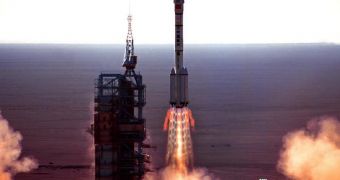Officials with the China National Space Administration (CNSA) announced that the Shenzhou 8 unmanned space capsule will launch to Earth's orbit in early November. The purpose of the mission is to see whether the vehicle can dock to the Tiangong-1 module, which was launched just last month.
China has a very ambitious space program, which is spread out in numerous directions. These include building a space station by 2020, sending people to the Moon, sending robotic probes to Mars and other planets, and testing spacecraft docking and undocking procedures in orbit.
The new announcement was made on Wednesday, October 26, by the Xinhua state news agency. The vehicle will take off from the Jiuquan Satellite Launch Center, in northwest China, the statement added.
The mission will be lifted to low-Earth orbit aboard an upgraded Chinese Long March-2F delivery system, which was modified specifically for this mission. China plans to complete its first space station by no later than 2020, which is when the International Space Station is marked for retirement.
When both Tiangong-1 and Shenzhou 8 are in space, mission controllers will send commands to the two spacecraft, ordering them to maneuver close to each other, and then dock. If CNSA achieves this, then it will essentially have proven that it can start constructing an orbital facility, Space reports.
The Xinhua statement says that Shenzhou 8 and its Long March 2F rocket were delivered to their launch pad this morning (October 27). The assembly took about 2 hours to travel the 1,500 meters (nearly 1 mile) separating the assembly and testing building at the JSLC from the launch platform.
Over the coming weeks, Chinese engineers will conduct a series of tests meant to assess whether the spacecraft and its delivery system are ready for launch. They will also carry out a number of dress rehearsals, practicing for early November.
In addition to these two spacecraft, CNSA also plans to launch the Shenzhou 9 and 10 vehicles, which will conduct a docking mission as well. What the agency is particularly interested in is demonstrating that it can perform docking/undocking maneuvers whenever it wants.
Construction on the planned, 60-ton space station will begin only after this capability is established, and engineers learn how to deal with emergency situations. CNSA recognizes the perils associated with long-term space exploration, and is determined to make the orbital platform as safe as possible.

 14 DAY TRIAL //
14 DAY TRIAL //